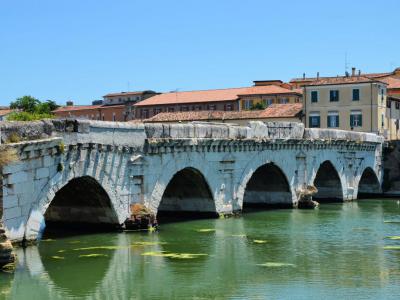
Ponte di Tiberio (Tiberius Bridge), Rimini (must see)
In 1995, archeologist Vittorio Galliazzo edited a list of the surviving Roman bridges in Italy and all provinces of the Roman Empire. The number came to 900. Those were only the ones still standing. The number of bridges built must be significantly greater. Roman bridge builders were seeking connections to the gods.
Rimini has a harmonious combination of function and spirituality: the Bridge of Augustus and Tiberius spanning the Marecchia River. Construction started in 14 AD, in the last years of the reign of Augustus. The Emperor, Pontifex Maximus, was the one entrusted with bridges. Construction finished in 21 AD.
Rimini was a central nexus in the all-important road system of Roman Italy. The Tiberius Bridge, built at the beginning of Emilia street, led to the Piacenza commune. It was also the beginning of Popilia street, leading to the city of Ravenna, and the famed Flaminia street, leading to Rome.
The Tiberius Bridge, made entirely of Istrian stone, is done in the Doric style with five arches. It is 243 feet long and paved with the usual trachybasalt cobbles. The span is curved slightly, forming a "donkey back" shape. Above the arches are niches framed with pilasters carrying tablets and pediments.
The cornices, covered with a coping on top, are supported by modillions and dentils. An inscription near the coping claims "given by both Emperors." The arches, supported by heavy, massive pillars, stand in water using a system of poles and breakwater buttresses set against the axis.
The Bridge of Tiberius survived earthquakes in 1672 and 1786, the Greek-Gothic War of 552, and the arson attempts of Pandolfo Malatesta in 1528. The retreating German army destroyed almost every bridge on the Marecchia River in World War II. Only the Bridge of Tiberius remained behind in their swath of devastation.
Tiberius Bridge is open to pedestrian traffic and light vehicles. It is a beautiful sight from the Sull'Aqua Square, overlooking the reservoir.
Rimini has a harmonious combination of function and spirituality: the Bridge of Augustus and Tiberius spanning the Marecchia River. Construction started in 14 AD, in the last years of the reign of Augustus. The Emperor, Pontifex Maximus, was the one entrusted with bridges. Construction finished in 21 AD.
Rimini was a central nexus in the all-important road system of Roman Italy. The Tiberius Bridge, built at the beginning of Emilia street, led to the Piacenza commune. It was also the beginning of Popilia street, leading to the city of Ravenna, and the famed Flaminia street, leading to Rome.
The Tiberius Bridge, made entirely of Istrian stone, is done in the Doric style with five arches. It is 243 feet long and paved with the usual trachybasalt cobbles. The span is curved slightly, forming a "donkey back" shape. Above the arches are niches framed with pilasters carrying tablets and pediments.
The cornices, covered with a coping on top, are supported by modillions and dentils. An inscription near the coping claims "given by both Emperors." The arches, supported by heavy, massive pillars, stand in water using a system of poles and breakwater buttresses set against the axis.
The Bridge of Tiberius survived earthquakes in 1672 and 1786, the Greek-Gothic War of 552, and the arson attempts of Pandolfo Malatesta in 1528. The retreating German army destroyed almost every bridge on the Marecchia River in World War II. Only the Bridge of Tiberius remained behind in their swath of devastation.
Tiberius Bridge is open to pedestrian traffic and light vehicles. It is a beautiful sight from the Sull'Aqua Square, overlooking the reservoir.
Want to visit this sight? Check out these Self-Guided Walking Tours in Rimini. Alternatively, you can download the mobile app "GPSmyCity: Walks in 1K+ Cities" from Apple App Store or Google Play Store. The app turns your mobile device to a personal tour guide and it works offline, so no data plan is needed when traveling abroad.
Ponte di Tiberio (Tiberius Bridge) on Map
Sight Name: Ponte di Tiberio (Tiberius Bridge)
Sight Location: Rimini, Italy (See walking tours in Rimini)
Sight Type: Attraction/Landmark
Guide(s) Containing This Sight:
Sight Location: Rimini, Italy (See walking tours in Rimini)
Sight Type: Attraction/Landmark
Guide(s) Containing This Sight:
Walking Tours in Rimini, Italy
Create Your Own Walk in Rimini
Creating your own self-guided walk in Rimini is easy and fun. Choose the city attractions that you want to see and a walk route map will be created just for you. You can even set your hotel as the start point of the walk.
Rimini Introduction Walking Tour
The Roman Republic founded an outpost called Ariminus at the mouth of the river Marecchia in 268 BC. Rimini was a center of civil wars and invasions. Julius Caesar made his famous "Rubicon" speech to his troops in the city forum.
The city was an all-important junction. The ancient Roman road, via Flaminia, ended in Rimini at the Arch of Augustus, erected in 27 BC. Another old Roman... view more
Tour Duration: 2 Hour(s)
Travel Distance: 2.4 Km or 1.5 Miles
The city was an all-important junction. The ancient Roman road, via Flaminia, ended in Rimini at the Arch of Augustus, erected in 27 BC. Another old Roman... view more
Tour Duration: 2 Hour(s)
Travel Distance: 2.4 Km or 1.5 Miles
Federico Fellini Trail
Even those vaguely familiar with cinema perhaps have heard of Federico Fellini. In recent history, the picturesque resort town of Rimini, on the Adriatic coast of Italy, "marked" itself primarily as the birthplace and the final resting place of this great film director.
Fellini lived in Rimini from January 1920, when he was born, until January 1939, when he moved out to Rome. While... view more
Tour Duration: 2 Hour(s)
Travel Distance: 3.4 Km or 2.1 Miles
Fellini lived in Rimini from January 1920, when he was born, until January 1939, when he moved out to Rome. While... view more
Tour Duration: 2 Hour(s)
Travel Distance: 3.4 Km or 2.1 Miles


